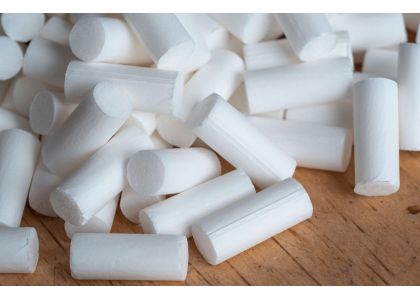
Cellulose acetate tow (CAT) has been around for decades despite its notoriously bad biodegradability properties. But environmentally friendly filter materials are forcefully pushing onto the scene and just might give CAT a serious run for its money in the near future.
Cellulose acetate tow – or CAT - is today the most commonly used raw material for manufacturing cigarette filter plugs. Or rather, it’s always been, maintaining a quasi-monopoly status. That status may be justified, though. After all, CAT imparts exceptional filtering and retention properties. But, it also decomposes notoriously slowly. Additionally, during the making of filter rods the individual fibers need to be bonded together with a synthetic glue or resin, most commonly triacetine, and that doesn’t really help improve biodegradability either.
The littering of CAT filters is, of course, a problem that contributes to environmental pollution. Each year up to 120 billion butts are carelessly thrown away on streets and sidewalks or end up in gutters, forests, parks, lakes, and rivers, in the oceans, on beaches, and where not. According to an audit conducted by the San Francisco city council some years ago, cleaning up this mess costs the municipality (and thus the taxpayer) more than US$7 million annually. And, despite being produced from cellulose fibers, the material has been chemically altered to form a polymer that stubbornly resists natural decomposition. Various studies over the decades have established that CAT filters can take anywhere from two to ten years to biodegrade. Bacteria and other microorganisms simply find it too hard to digest.
Cigarette companies have of course always scouted for alternative filter materials as replacements for CAT, but with little success. There just appears to be nothing that can match all the tried and tested advantages that CAT offers, including taste neutrality, low thermo-conductivity, high heat resistance, ease of processing and, last but not least, cost efficiency. So, CAT is here to stay for the foreseeable future. Or is it? There are in fact a number of materials that could play a significant role in eventually delegating CAT to the annals of history – if their respective inventors or suppliers play it right.
But in the late 1990s, McAirlaids invented a patented process that allowed the airlaid cellulose fibers to bond without such glues or resins. This resulted in a highly pure yet durable material that could be used in the rather picky food, hygiene, and medical industries, for example, to make meat pads, wound dressings and female hygiene products, just to name a few. Since the product almost exclusively consists of untreated, unadulterated, entirely natural cellulose fibers, it also biodegrades very quickly.